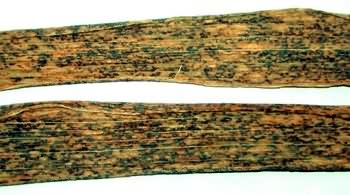Diseases
Ascochyta graminicola Sacc. - Ascochyta Leaf Spot of Rye
Systematic position.
Class Deuteromycetes, order Sphaeropsidales, family Sphaeropsidaceae, genus Ascochyta (Ainsworth, 1971). Now this species is referred to Mitosporic fungi (Hawksworth et al., 1995). Teleomorph - Mycosphaerella tassiana (de Not) Johans - class Ascomycetes, order Dothideales, family Dothideaceae (Hawksworth et al., 1995).Synonym.
Ascochyta hordei Hara.Biological group.
This species is a Hemibiotroph.Morphology and biology.
This species infects rye, cultivated and wild barley, wheat, and also species of Festuca, Holcus and Phleum (Ishkova et al., 2002). The lesion appears as small, oblong, albescent or yellowish spots with thin dark brown limbs on leaves, and as spots without limbs on stems. Later the spots coalesce, covering the entire leaf surface. Stalks become dirty gray, drying up. Pycnidia are spherical, colorless, dark brown to black, 100-180 microns in diameter. Pycnidiospores (conidia) are cylindrical to ellipsoid, colorless to pale-brown, with 1, less often 2 septa, 14-16 x 3-5 microns. During vegetation the pycnidiospores are the main source of the infection. The fungus over-winters as pycnidia on plant residues and as mycelium on leaves of winter crops.Distribution.
The fungus is distributed on all continents where plant-hosts are present. In Russia the fungus may be detected in all regions of cereal crop cultivation. The level of disease harmfulness varies in different zones. The highest development on rye is recorded in the northern regions of the Russian Federation.Ecology.
During vegetation the disease develops under rather damp and moderately warm summer weather conditions.Economic significance.
Ascochyta Leaf Spot weakly affects rye, only being able to develop strongly some years under favorable conditions for infestation. The disease can sometimes cause complete destruction of winter rye. Control measures include destruction of residues, isolation of rye crops from fields of wheat and barley, crop rotation, application of phosphorus-potash chemicals in autumn and use of fungicides during vegetation.Reference citations:
Ainsworth G.C., ed. 1971. Ainsworth and Bisby.s Dictionary of the Fungi. CAB International. 663 p.Hawksworth D.L., Kirk P.M., Sutton B.C., Pegler D.M. 1995. Ainsworth & Bisby.s Dictionary of the fungi. Kew: CAB International. 616 p.
Ishkova T.I., Berestetskaya L.I., Gasich E.L., Levitin M.M., Vlasov D.Yu. 2002. Diagnostics of the main fungus diseases of cereal crops. St. Petersburg: VIZR. 76 p. (In Russian
Nikitina E.V., Polozova N.L. 1990. Diagnostic of cereal fungus spots. Leningrad: VIZR. 69 p. (In Russian)
Shestiperova Z.I., Polozova N.L. 1973. Powdery mildew and leaf spots of spring wheat. Leningrad: Kolos. 56 p. (In Russian)
© Dmitriev A.P.


